|
             
| |
|
July
25, 2019
Artist Focus
The Legacy
Gallery
Jackson,
WY |
.jpeg_small.jpg) |
"Ashley Greets Beckwourth"
Oil 24" X 36"
Available
Legacy Gallery
Jackson, WY |
|
James Beckwourth (1798-1866) was mixed race, born
into slavery in Virginia, and was freed by his master (and father),
and later relocated to St. Louis where he
made connections with fur
traders. He was hired in 1824 by Wm. Ashley, who founded the Rocky
Mtn. Fur Co., as a wrangler on his expedition to explore the Rocky
Mountains. The adventurous
young men who joined up were known as “Ashley’s Hundred”. Ashley, an
entrepreneur, devised the rendezvous system where trappers, fur
traders, and Indians would
gather annually to exchange goods and socialize. Beckwourth became a
legendary guide and trapper, and lived with the Crow tribe, even
marrying a chief’s daughter. Before
Beckwourth eventually left the Rocky Man. Fur Co., Ashley
looked to him for assistance with trails, the best hunting and
trapping areas, and in dealing with Indians. Here, the two
greet each other at a
rendezvous after a long absence.
|
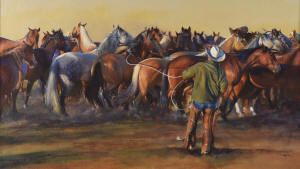 |
"Catch of the Day"
Watercolor 20" X 35"
Available
Legacy Gallery
Jackson, WY
|
|
Many historical ranches in the West, often
started as homesteads, operate as they did 100 years ago. The names
and faces of the cowboys may have changed but there are many
continuing traditions that remain. For example, here the remuda is
jingled into a rope corral early in the morning and tradition
dictates that the trail boss ropes each man's mount, here with a
left-handed houlihan for " the catch of the day".
|
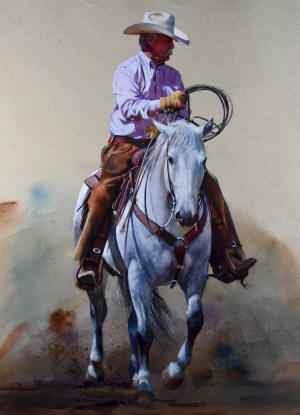 |
"Dependable"
Watercolor 21.5" X 14.5"
Available
Legacy Gallery
Jackson, WY |
|
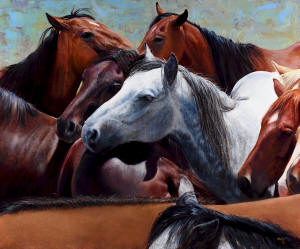 |
"Heads Up"
Oil 20" X 24"
Available
Legacy Gallery
Jackson, WY |
|
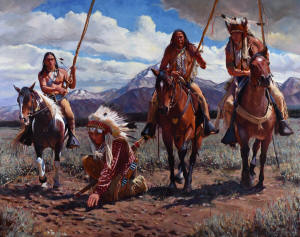 |
"The
Horse Catchers"
Oil 24" X 30"
Available
Legacy Gallery
Jackson, WY |
|
In the late eighteenth and early nineteenth
centuries capturing of wild horses was commonplace among the
northern Plains Indian tribes. Besides driving the wild horses into
a corral, often made from natural rock forms, there were
professional horse-catchers.
They rode the fastest and strongest horses and
were devoted to this endeavor full time. Before the use of the
lasso, or reata, became prevalent in the latter nineteenth century
these horsemen used willow branches with their ropes and passed them
over the horse's neck for capture.
The wild horses roamed in groups of 30-50
mares and youngsters and were under the leadership of one stallion,
who drove off other stallions. Here this group of braves were
tracking their prey.
|
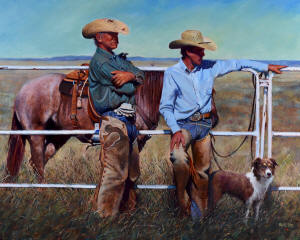 |
"Panel Discussion"
Oil 16" X 20"
Available
Legacy Gallery
Jackson, WY |
|
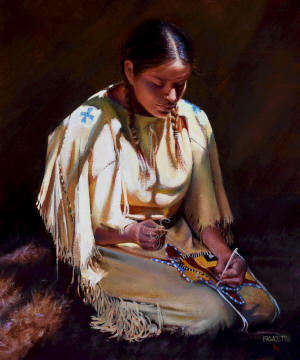 |
"Quillwork"
Oil 12" X 10"
Available
Legacy Gallery
Jackson, WY |
|
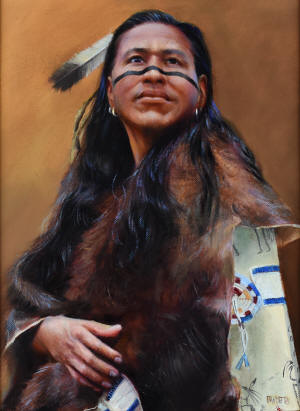 |
"Robe
of Valor"
Oil 12" X 9"
Available
Legacy Gallery
Jackson, WY |
|
The northern Plains Indians had three types of
buffalo hides they painted: abstract geometric designs painted by
women, exploit robes painted by men who performed brave deeds, and
winter counts painted by men. While tepees and shields bore more
spiritual symbols, the exploit robes depicted heroic deeds. The
paint used to adorn the buffalo robes was usually made from pigments
found in nature: berries, lichen and moss, vegetable matter, and
soil. This dignified brave wore his robe proudly, reflecting on his
moment of glory.
|
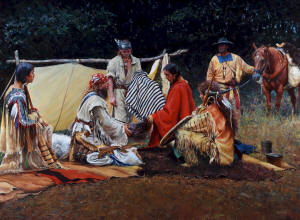 |
"Trading At Pierre's Hole"
Oil 30" X 40"
Available
Legacy Gallery
Jackson, WY |
|
During the height of the mountain man era, a huge
rendezvous was held in 1832 at Pierre's
Hole, currently the area of Jackson Hole, Wyoming. Named for "le
grand Pierre" Tivanitagon, a
Hudson's Bay Company trader, this valley or "hole" provided numerous
beaver rich streams and plentiful game. This was one of the largest
rendezvous in the Rocky Mountains with four hundred mountain men and
several hundred lodges of Nez Perce and Flatheads, and over three
thousand horses. Usually lasting over two weeks, these yearly
gatherings provided trappers an outlet for trading and resupplying
themselves, as well as for recreation and entertainment, gambling,
contests, and games.
|
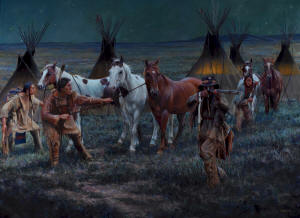 |
"Under The Cover of Darkness"
Oil 30" X 40"
Available
Legacy Gallery
Jackson, WY |
|
Horses were an
integral part of the Native American society by the mid 19th
century. The Plains Indian society was changed by it’s ability to
move frequently, hunt buffalo
herds as they roamed, and quarrel with other tribes. Wealth and
power often equated with the number and quality of horses the chief
and his family owned. It was common,
because of their value, to obtain horses by any means
possible like the braves stealing “ under the cover of darkness”.
|
|